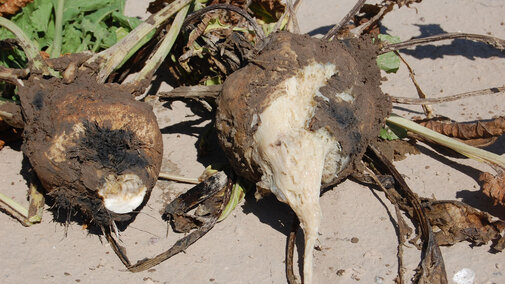Almost two years ago, I introduced the idea of Nebraska serving as a breeding ground for the discovery of new plant diseases. This has been particularly evident with bacterial diseases, specifically those caused by Gram-positive pathogens.
“Gram” refers to the reaction of the bacterium’s cell-wall structure to a microscopic dye that broadly differentiates bacteria into two primary groups — negative and positive. This was named for the Danish bacteriologist Hans Christian Gram, who developed the technique.
Characteristics
Although the majority of plant-pathogenic bacteria are Gram-negative, there is a group of Gram-positive bacterial pathogens that cause damaging diseases in some crops. Nebraska appears to be the original home for a number of these pathogens that have historically been extremely important to major field crops grown here.
This diverse group of bacteria varies in shape and size, but exhibits similar short, irregular rods that may be slightly curved, or club-shaped. They are common inhabitants of soil, constituting a large and important component of the soil microflora, consisting of both pathogens and saprophytes (microorganisms that live on dead or decaying matter).
A New Root Disease in Sugarbeets
Two well-known examples of this group of bacterial pathogens (due to recent epidemics in Nebraska) are bacterial wilt of dry beans and Goss’ wilt of corn. However, did you know that another obscure disease representative of this group was reported much earlier than bacterial wilt or Goss’ wilt and is probably lesser known than either? The first report involving this group of bacteria, apparently native to Nebraska, was a new root-rot disease of sugarbeets in 1901 by George Hedgcock, a graduate student Charles Bessey, an early plant pathologist at the University of Nebraska.
Haven Metcalf
Haven Metcalf, another student of Bessey’s, may be better remembered today for his pioneering work with forest pathology. As head of the Bureau of Plant Industry’s Forest Pathology Investigations, he became a celebrated figure working with chestnut blight, publishing the first general U.S. Department of Agriculture bulletin on this disease in 1909. Metcalf later chose his close friend and graduate-school colleague, George Hedgcock, to lead the investigations on the different rust disease problems of conifers and surveying for diseases in the national forests in the western United States.
Metcalf arrived in Lincoln in 1901 as one of the few trained bacteriologists at that time. He became the first instructor of this subject at the University of Nebraska, teaching while also studying with Bessey. His presence in the department also introduced the new bacterial techniques to the school.
Wet Rot of Sugarbeet
In that same year of 1901, Hedgcock brought to Metcalf’s attention a destructive wet rot of sugarbeet. Studies began in 1902 and the disease was further found to be widespread and prevalent throughout Nebraska — and also to some extent in Arizona and Colorado. With the assistance of Hedgcock, Metcalf determined the disease to be of bacterial origin.
Strangely, symptoms of the disease were observed only on mature roots, starting at the root tip and moving upward toward the crown, eventually resulting in a soft, sticky mass of decayed tissues. No foliar symptoms were observed until the entire root was destroyed and leaves suddenly collapsed and turned black. No infections were ever noted on young plants in fields or on seedlings after inoculations in the greenhouse.
The pathogen was identified as a white-colored, Gram-positive, non-motile (not capable of motion) bacterium, but not viscous. Metcalf concluded that the disease was new, caused by a never-before described pathogen, and named it Bacterium teutlium. The study of this new disease became Metcalf’s Ph.D. topic, completing it in 1904.
It is now assumed that this bacterium is a member of a group closely related to various lactic acid bacteria utilized for the production of acid from the fermentation of silage. Nevertheless, regardless of what its identity actually was, it began a string of plant disease reports to come for Gram-positive bacterial pathogens from Nebraska.

